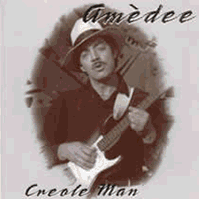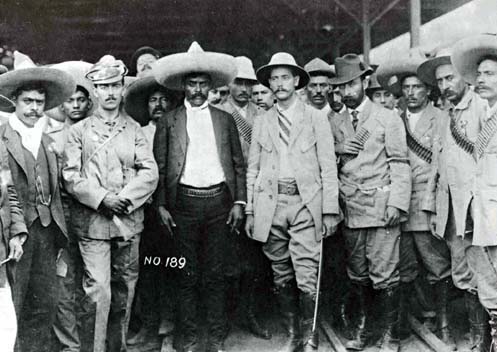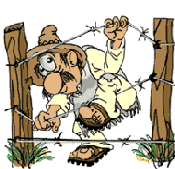| |
De Emiliano Zapata
The horseman and muledriver Emiliano
Zapata, hero of the 1910 social revolution, led a "peasant
army" based in the Cuautla valley 70 miles south of Mexico
City. In addition to many military victories, Zapata organized
peasant committees out of which came position papers on land
reform.
An important part of his Cuautlan peasant committee land reform
was incorporated into the 1917 Constitution of Mexico, to the
benefit of the campesinos throughout the nation. As for Zapata's
origins: Birth records for Zapata were burned in a town fire,
and race was not noted in Mexican government records of his
time.
Spanish census data did show race, and from it some extrapolations
can be made. Zapata was said to be from a family that went back
generations in the valley, and it was said that by Emiliano's
time, all of the old families were interbred in one manner or
another.
The valley was just under 50% Afro-Mexican in late colonial
times. Zapata was of peasant roots, and among those with this
ancestry, Afro-Mexicans well outnumbered Indigenous and the
few mestizo and white peasants. A narrowed geographic sampling
finds Zapata's home village of Anenecuilco and surrounding villages
had a population of 101 families of Afro-Mexicans, 32 Indigenous
families, 5 of mixed Afro-Mexican and Indian, 4 mestizo, and
3 white families.
The Spanish data for
Cuautla shows 4 households of Zapatas. Three of the four are
Afro-Mexican, "pardo." One of the Afro-Mexican Zapata
homes was next door to two Afro-Mexican families with the
name of one of Emiliano's other grandparent lines, the Cerezos.
All told, two thirds of the families of Emiliano grandparent
lines were Afro-Mexican. More details on the probable roots
of Emiliano are in the explanation to the photograph of his
sister Maria de la Luz.
Born
on August 8, 1879, in the village of Anenecuilco, Morelos (Mexico),
Emiliano Zapata was of mestizo heritage and the son of a peasant
medier, (a sharecropper or owner of a small plot of land). From
the age of eighteen, after the death of his father, he had to
support his mother and three sisters and managed to do so very
successfully.
The little farm prospered enough to allow Zapata
to augment the already respectable status he had in his native
village. In September of 1909, the residents of Anenecuilco
elected Emiliano Zapata president of the village's "defense
committee," an age-old group charged with defending the
community's interests. In this position, it was Zapata's duty
to represent his village's rights before the president-dictator
of Mexico, Porfirio Díaz, and the governor of Morelos,
Pablo Escandón.
 C mulatto People C mulatto People |
During the 1880s, Mexico
had experienced a boom in sugar cane production, a development
that led to the acquisition of more and more land by the hacienderos
or plantation owners. Their plantations grew while whole villages
disappeared and more and more medieros and other peasants lost
their livelihoods or were forced to work on the haciendas.
It was under these conditions that a plantation called El Hospital
neighboring Zapata's village began encroaching more and more
upon the small farmers' lands. This was the first conflict in
which Emiliano Zapata established his reputation as a fighter
and leader. He led various peaceful occupations and re-divisions
of land, increasing his status and his fame to give him regional
recognition.
In 1910, Francisco Madero, a son of wealthy plantation owners,
instigated a revolution against the government of president
Díaz. Even though most of his motives were political
(institute effective suffrage and disallow reelections of presidents),
Madero's revolutionary plan included provisions for returning
seized lands to peasant farmers.
The latter became a rallying
cry for the peasantry and Zapata began organizing locals into
revolutionary bands, riding from village to village, tearing
down hacienda fences and opposing the landed elite's encroachment
into their villages.
On November 18, the federal government began rounding up Maderistas
(the followers of Francisco Madero), and only forty-eight hours
later, the first shots of the Mexican Revolution were fired.
While the government was confident that the revolution would
be crushed in a matter of days, the Maderista Movement kept
gaining in strength and by the end of November, Emiliano Zapata
had fully joined its ranks. Zapata, a rather cautious, soft-spoken
man, had become a revolutionary.
 |
| Zapata the Revolutionary Hero |
|
| The hero of the 1910 social revolution, |
| More videos ...Video1...Video 2...Video 3 |
During the first weeks of 1911, Zapata continued to build his
organization in Morelos, training and equipping his men and
consolidating his authority as their leader. Soon, Zapata's
band of revolutionaries, poised to change their tactics and
take the offensive, were known as Zapatistas.
On February 14,
Francisco Madero, who had escaped the authorities to New Orleans,
returned to Mexico, knowing that it was time to restart his
revolution with an all-out offensive. Less than a month later,
on March 11, 1911, "a hot, sticky Saturday night,"
the bloody phase of the Mexican Revolution began at Villa de
Ayala. There was no resistance from the villagers, who were
mostly sympathetic to the revolution, being sharecroppers or
hacienda workers themselves, and the local police were disarmed
quickly.
Not all battles that followed were this quick, however. The
revolution took its bloody course with the legendary Pancho
Villa fighting in the northern part of Mexico, while Zapata
remained mainly south of Mexico City. On May 19, after a week
of extremely fierce fighting with government troops, the Zapatistas
took the town of Cuautla. Only forty-eight hours later, Francisco
Madero and the Mexican government signed the Treaty of Ciudad
Juárez, which ended the presidency of Porfirio Díaz
and named Francisco León de la Barra, former ambassador
to Washington, as interim president
| Maria de la Luz Zapata |
Mixed race families often have siblings of contrasting hues andfeatures. Maria de la Luz Zapata appears darker and more African than Emiliano, and both Emiliano and Maria are darker than their sister Maria de Jesus and their brother Eufemio.
Regarding photos: it may be noted that Emiliano tended to be lighter in color when photographed alone and the exposure could be set to lighten him. When photographed in a group that included whites he tends to appear darker, perhaps because to lighten him might white out the whites entirely. Politically, the land reform for which Emiliano fought in 1910 involved legal questions that pitted Indigenous vs. the non-Indigenous.
He and his family were considered Indigenous. They were one family among many that were quite dark complexioned Indigenous.
Tecla aqui para regresar
|
| |
His Ancestry |
|
| |
Source.......The Mexican Mulatto connection
|
|
| |
Emiliano Zapata
, The horseman and mule driver and hero of the 1910 social revolution,
led a "peasant army" based in the Cuautla valley 70 miles south of Mexico City. In addition to many military victories, Zapata organized peasant committees out of which came position papers on land reform. An important part of his Cuautlan peasant committee land reform was incorporated into the 1917 Constitution of Mexico, to the benefit of the campesinos throughout the nation.
As for Zapata's origins: Birth records for Zapata were burned in a town fire, and race was not noted in Mexican government records of his time. Spanish census data did show race, and from it some extrapolations can be made. Zapata was said to be from a family that went back generations in the valley, and it was said that by Emiliano's time, all of the old families were interbred in one manner or another.
The valley was just under 50% Afro-Mexican in late colonial times. Zapata was of peasant roots, and among those with this ancestry, Afro-Mexicans well outnumbered Indigenous and the few mestizo and white peasants. A narrowed geographic sampling finds Zapata's home village of Anenecuilco and surrounding villages had a population of 101 families of Afro-Mexicans, 32 Indigenous families, 5 of mixed Afro-Mexican and Indian, 4 mestizo, and 3 white families.
The Spanish data for Cuautla shows 4 households of Zapatas. Three of the four are Afro-Mexican, "pardo." One of the Afro-Mexican Zapata homes was next door to two Afro-Mexican families with the name of one of Emiliano's other grandparent lines, the Cerezos.
All told, two thirds of the families of Emiliano grandparent lines were Afro-Mexican. More details on the probable roots of Emiliano are in the explanation to the photograph of his sister Maria de la Luz.
Tecla aqui para regresar
|
|
.
|
|

